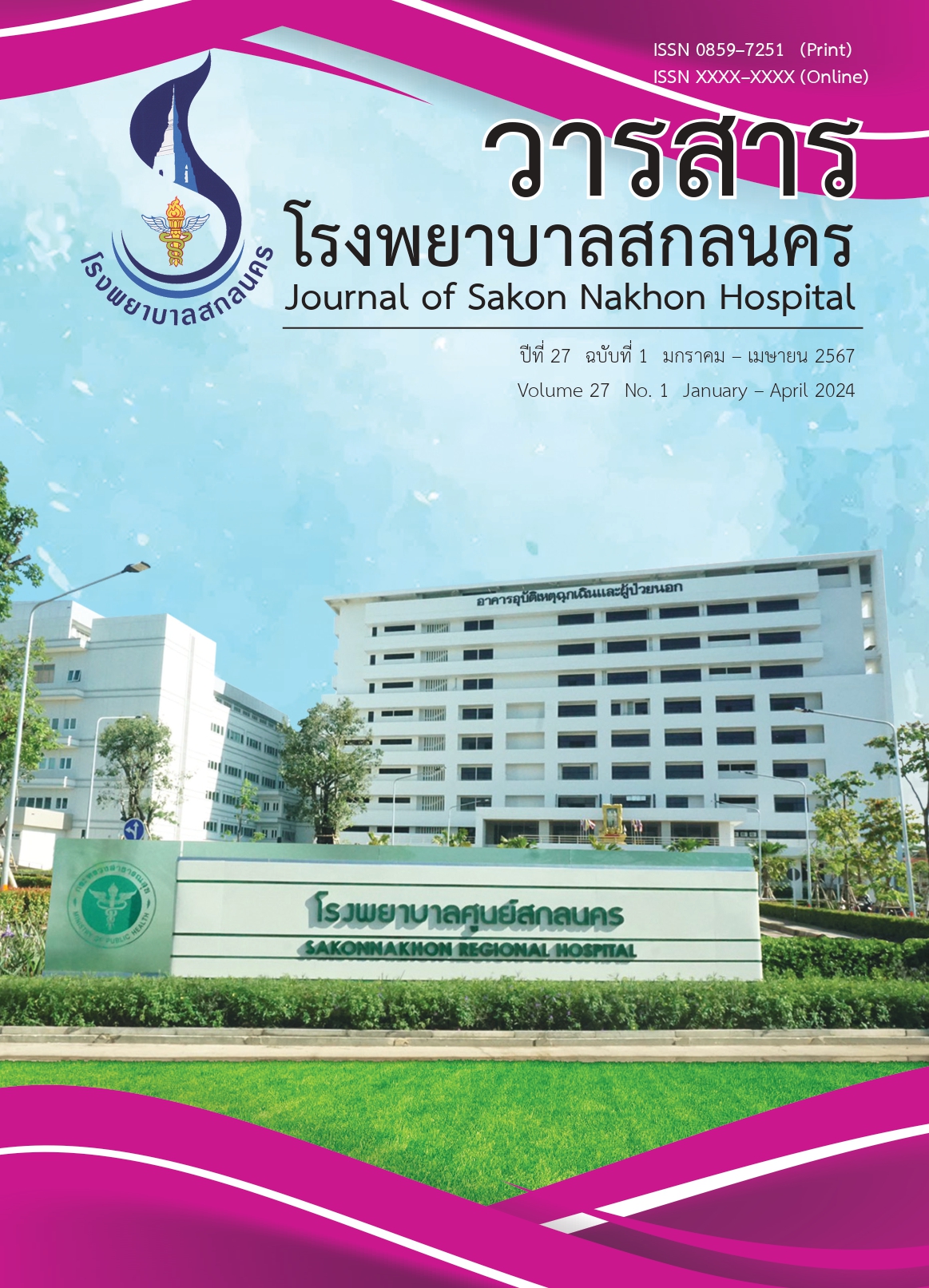Factors Affecting Receiving the COVID–19 vaccine in Children Aged 6 Months to 4 Years at the Service Area of Sukasem Community Health Center, Sakon Nakhon Hospital
Keywords:
Children aged six months to 4 years, COVID-19 vaccine, Stimulating factorsAbstract
Children under five years of age who have not yet received the COVID–19 vaccine exhibit a higher rate of illness than older children. This study aimed to investigate the factors affecting COVID–19vaccination in children agedsix months to4years in serviceareaofSukkasem community health center, Sakon Nakhon hospital. The cross–sectional study was conducted in 240 parents of thosechildren between June1and November30,2023. Data were collected using the questionnaire covering general information about parents and children, knowledge, perceptions and vaccination
against COVID–19. Data were analyzed using the descriptive and inferential statistics; simplelogisticregression and multiple logistic regression.
The results revealed that 37 children received the COVID–19 vaccine (15.4%). The factors affecting COVID–19vaccination in children aged6 months to4years includedparent gender (male) (Adj. OR = 0.36; 95% CI = 0.13–0.98), age (Adj. OR = 0.93; 95% CI = 0.86–0.99), relationship with children (grandfather/grandmother) (Adj. OR = 37.19; 95% CI = 3.49–396.34), education level (associate degree or higher) (Adj. OR = 6.13; 95% CI = 1.69–22.29), The factors in health belief model aspect included perception of barriers to vaccination (moderate level) (Adj. OR = 0.12; 95% CI = 0.02–0.75) and receiving advice from medical personnel, village health volunteers, family members and neighbors (Adj. OR = 25.02; 95% CI = 1.94–323.48). The children personal factors included age (Adj. OR = 1.98; 95%CI = 1.09–3.58) and past COVID–19 infection (Adj. OR = 4.71; 95%CI = 1.57–14.13). Therefore, thepromotingfactors influencing parents’ decision–makingshould be encouraged to receive vaccination among children aged 6 months to 4 years, thereby reducingthe severity of COVID–19 infection.
References
กองโรคติดต่อทั่วไป กรมควบคุมโรค กระทรวงสาธารณสุข. รวมแนวทางการเผ้าระวัง ป้องกัน และควบคุมโรคติดเชื้อไวรัสโคโรนา 2019 สำหรับบุคลากรทางการแพทย์และสาธารณสุข [อินเทอร์เน็ต]. 2564 [เข้าถึง เมื่อ 29 สิงหาคม 2566]. เข้าถึงได้จาก: https://dmsic.moph.go.th/index/detai/8671
สมาคมโรคติดเชื้อในเด็กแห่งประเทศไทย. ทะเบียนผู้ป่วยยืนยัน และทะเบียนผู้เสียชีวิตกรมควบคุมโรคแหล่งข้อมูล: กรมควบคุมโรค ณ วันที่ 22 พฤษภาคม 2566 สถานการณ์โควิด19 ของประเทศไทย [อินเทอร์เน็ต]. 2566 [เข้าเมื่อ 29 สิงหาคม 2566]. เข้าถึงได้จาก: https://www.pidst.or.th/A1328.html
กองโรคติดต่อทั่วไป/สำนักสื่อสารความเสี่ยงฯ กรมควบคุมโรค. กรมควบคุมโรค ร่วมกับภาคีเครือข่าย เร่งรัด สร้างภูมิปฐมวัย ปกป้องภัยโควิด 19 [อินเทอร์เน็ต]. 2564 [เข้าเมื่อ 28 ตุลาคม 2566]. เข้าถึงได้จาก: https://pr.moph.go.th/print.php?url=pr/print/2/02/180650/
ราชวิทยาลัยกุมารแพทย์แห่งประเทศไทย. คำแนะนำฉีดวัคซีนโควิด19 สำหรับเด็กและวัยรุ่น ฉบับที่ 7 [อินเทอร์เน็ต]. 2565 [เข้าเมื่อ 29 สิงหาคม 2566]. เข้าถึงได้จาก: https://www.thaipediatrics.org/?p=1761
กระทรวงสาธารณสุข. รายงานสถานการณ์ให้บริการฉีดวัคซีนโควิด19 [อินเทอร์เน็ต]. 2565 [เข้าเมื่อ 2 สิงหาคม 2566]. เข้าถึงได้จาก: https://ddc.moph.
go.th/vaccine-covid19/getFiles/9/1676364714762.pdf
Hfocus.org เจาะลึกระบบสุขภาพ. กรมควบคุมโรคส่งไฟเซอร์ฝาม่วง 6 พ.ค.รองรับกลุ่มอายุ 12-17 ปี รองรับนักเรียนเปิดเทอม[อินเทอร์เน็ต]. 2565 [เข้าเมื่อ 29 สิงหาคม 2566]. เข้าถึงได้จาก: https://www.hfocus.org/content/2022/05/25033
ชุติมา บุญทวี ปัจจัยที่ส่งผลต่อการตัดสินใจฉีดวัคซีนป้องกันโคโรนาไวรัส (COVID-19) เข็มกระตุ้นของบุคลากรกลุ่มงานพยาบาลโรงพยาบาลตำรวจ. ว. วิจัยเพื่อการส่งเสริมสุขภาพและคุณภาพชีวิต 2565;2(2):49–60.
เนตรนภา สาสังข์, ธนพล อุทัยกาล, พิมพ์ชนก วรจันทร์, และ สโรชา แก้วปานกัน. ปัจจัยที่มีความสัมพันธ์กับการตัดสินใจในการฉีดวัคซีนป้องกันโรคโควิด-19 ของผู้ปกครองเด็กอายุ 0 - 4 ปี โรงพยาบาลบางปะหัน อำเภอบางปะหัน จังหวัดพระนครศรีอยุธยา. ว. วิจัยและพัฒนา วไลยอลงกรณ์ ในพระบรมราชูปถัมภ์ สาขา
วิทยาศาสตร์และเทคโนโลยี 2566;18(2):61–73.
อาภาพร เผ่าวัฒนา, สุรินธร กัมพากร, สุนีย์ ละกำปั่น, และทัศนีย์ รวิวรกุล. การเสริมสร้างสุขภาพและป้องกันโรคในชุมชน : การประยุกต์แนวคิดและทฤษฎีสู่การปฏิบัติ. กรุงเทพฯ: โครงการพัฒนาตำราและหนังสือวิชาการ คณะสาธารณสุขศาสตร์ มหาวิทยาลัยมหิดล; 2561.
Evaluation of Student Learning. New York: Mc Graw-Hill Book Company. Yamane, T. Statistics: An Introductory Analysis. 2d ed. New York: Harper and Row; 1970.
Khan YH, Rasheed M, Mallhi TH, Salman M, Alzarea AI, Alanazi AS, et al. Barriers and facilitators of childhood COVID-19 vaccination among parents: A systematic review. Front Pediatr 2022;10:950406.
Smailbegovic MS, Laing GJ, Bedford H. Why do parents decide against immunization? The effect of health beliefs and health professionals. Child Care Health Dev 2003;29(4):303–11.
Myers LB, Goodwin R. Determinants of adults’ intention to vaccinate against pandemic swine flu. BMC Public Health 2011;11(1):15.
Walker KK, Head KJ, Owens H, Zimet GD. A qualitative study exploring the relationship between mothers’ vaccine hesitancy and health beliefs with COVID-19 vaccination intention and prevention during the early pandemic months. Hum Vaccines Immunother 2021;17(10):3355–64.
Horiuchi S, Sakamoto H, Abe SK, Shinohara R, Kushima M, Otawa S, et al. Factors of parental COVID-19 vaccine hesitancy: A cross sectional study in Japan. PLoS ONE 2021;16(12):e0261121.
Chen F, He Y, Shi Y. Parents’ and Guardians’ Willingness to Vaccinate Their Children against COVID-19: A Systematic Review and Meta-Analysis. Vaccines 2022;10(2):179.
กองบริหารงานทั่วไป มหาวิทยาลัยมหิดล. สถานการณ์เด็กกับโรคขาดธรรมชาติ: เด็กกับสังคมสูงวัย สภาวะเปลี่ยนแปลง [อินเทอร์เน็ต]. 2565 [เข้าถึงเมื่อ 31 มกราคม 2567]. เข้าถึงได้จาก: https://op.mahidol.ac.th/ga/posttoday-18/
Wan X, Huang H, Shang J, Xie Z, Jia R, Lu G, et al. Willingness and influential factors of parents of 3-6-year-old children to vaccinate their children with the COVID-19 vaccine in China. Hum Vaccines Immunother 2021;17(11):3969–74.
Montalti M, Rallo F, Guaraldi F, Bartoli L, Po G, Stillo M, et al. Would Parents Get Their Children Vaccinated Against SARS-CoV-2? Rate and Predictors of Vaccine Hesitancy According to a Survey over 5000 Families from Bologna, Italy. Vaccines. 2021 Apr 10;9(4):366.
Shati AA, Al-Qahtani SM, Alsabaani AA, Mahmood SE, Alqahtani YA, AlQahtani KM, et al. Perceptions of Parents towards COVID-19 Vaccination in Children, Aseer Region, Southwestern Saudi Arabia. Vaccines 2022;10(8):1222.
Humble RM, Sell H, Wilson S, Sadarangani M, Bettinger JA, Meyer SB, et al. Parents’ perceptions on COVID-19 vaccination as the new routine for their children ≤ 11 years old. Prev Med 2022;161:107125.
Rogers RW. A Protection Motivation Theory of Fear Appeals and Attitude Change1. J Psychol 1975;91(1):93–114.
Kilic M, Ustundag Ocal N, Uslukilic G. The relationship of Covid-19 vaccine attitude with life satisfaction, religious attitude and Covid-19 avoidance in Turkey. Hum Vaccines Immunother 2021;17(10):3384–93.
Goruntla N, Ayisha MU, Sreeram M. Predictors of Parents’ Willingness to Vaccinate Their Children Against COVID-19 in India: A Web-Based Cross-Sectional Survey. Health Serv Res Manag Epidemiol 2023;10:23333928231175798.
Khan YH, Mallhi TH, Salman M, Tanveer N, Butt MH, Mustafa ZU, et al. Parental Perceptions and Barriers towards Childhood COVID-19 Vaccination in Saudi Arabia: A Cross-Sectional Analysis. Vaccines 2022;10(12):2093.
Evans M, Stoddart H, Condon L, Freeman E, Grizzell M, Mullen R. Parents’ perspectives on the MMR immunisation: a focus group study. Br J Gen Pract 2001;51(472):904–10.
Downloads
Published
How to Cite
Issue
Section
License
บทความที่ตีพิมพ์ถือว่าเป็นลิขสิทธิ์ของวารสารโรงพยาบาลสกลนคร การคัดลอกเพื่อพัฒนาเชิงวิชาการต้องได้รับการอ้างอิงอย่างถูกต้อง






